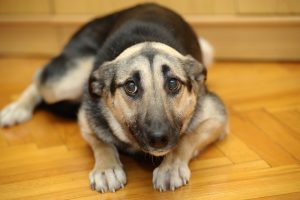 Dogs can be frightened or phobic of people, places, noises and objects. Common noise phobias are to thunder, fireworks, hot air balloons, trash trucks or construction equipment. We’ve also seen dogs that are afraid of outside air conditioning compressors, and various indoor appliances, including the ‘beep’ from the microwave and smoke alarms.
Dogs can be frightened or phobic of people, places, noises and objects. Common noise phobias are to thunder, fireworks, hot air balloons, trash trucks or construction equipment. We’ve also seen dogs that are afraid of outside air conditioning compressors, and various indoor appliances, including the ‘beep’ from the microwave and smoke alarms.
If your Fido is afraid of people, the most common reason is because he isn’t well socialized. Poorly socialized dogs didn’t have the chance to have pleasant experiences with all different types of people during puppy hood. A lack of socialization can also contribute to noise phobias and generalized fears of anything new and different.
Your dog needn’t have had a traumatic experience with something to become frightened of it. Just because your dog is afraid of certain people, don’t jump to the conclusion that he was abused before you got him. Poor socialization is more likely the cause. Dogs seem more likely to be afraid of men then women, for reasons not entirely understood. In general, men appear more intimidating just because they are physically larger, speak in deeper voices, and are usually less “delicate” or gentle in their movements as compared to women.
Most dogs that are afraid of people can learn to be friendlier, but some may never be social butterflies who are at ease with everyone. Some fearful dogs are also defensive, meaning they are threatening or aggressive to familiar or unfamiliar people as well. If your dog has snapped at or bitten someone we recommend seeking help from a qualified behavior consultant immediately, preferably a certified applied or veterinary behaviorist. Speak first with your veterinarian so potential medical problems for aggression can be evaluated.
Some dogs are more prone to fearful behavior than others. Although fearful behaviors aren’t inherited, a dog’s genetic makeup can result in a tendency, or lower threshold, for fear related problems.
Almost all fearful behavior problems require counter conditioning and desensitization techniques to resolve. These procedures expose your dog to softer, quieter, or more tolerable versions of whatever he is afraid of while pairing these events with something overwhelmingly enjoyable for your dog. Usually, this is an irresistible tidbit, or perhaps a toy your dog is fanatic about.
It’s vital that the behavior modification techniques be used correctly, and precisely, otherwise they either won’t work or can make the problem worse.
For noise phobias such as fireworks, gunshots, etc., the sounds are difficult to re-create with the necessary varying degrees of intensity.
We have all kinds of online courses to help you on PetProWebinars.com